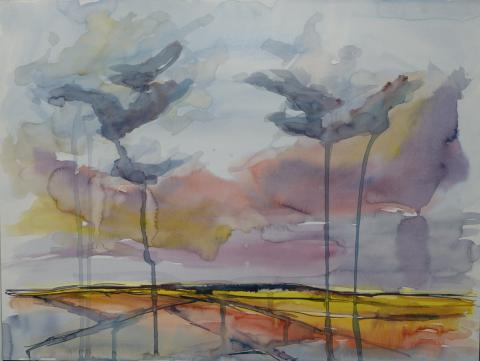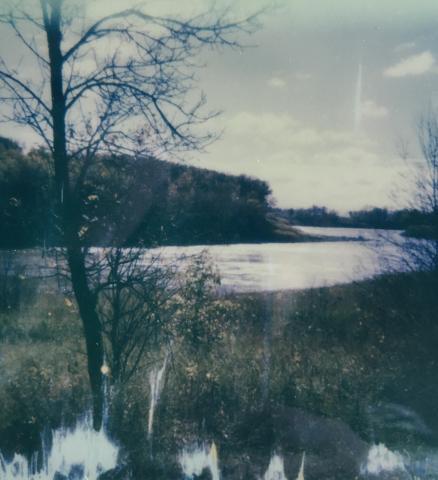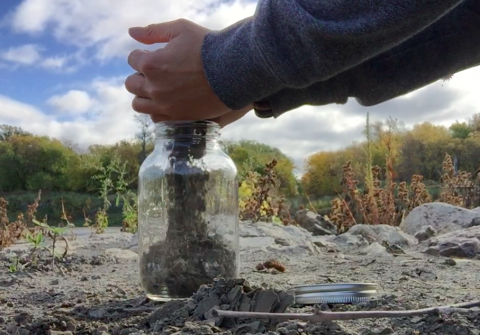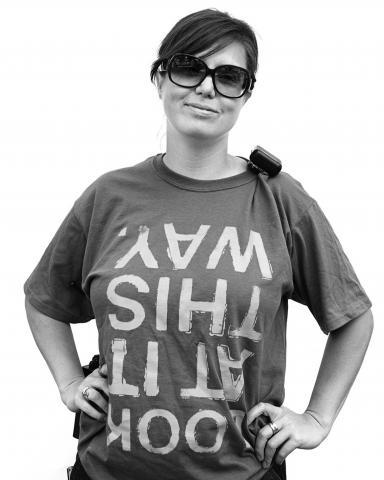Profile photo by Aaron Pederson
BACHELOR OF FINE ART IN PAINTING, 1998
BACHELOR OF FINE ART IN CERAMICS, 1999
Arkatyiss MILLER: When did you graduate ACAD? What was your major? Do you continue to work in this area or did you change areas of interest?
Dawn Saunders DAHL: I graduated in 1998 in Painting, and 1999 in Ceramics. It was known as ACA then. At that time the name was changing to ACAD and they were moving toward a degree granting from the diploma system. I currently continue to paint and create ceramics when I can get access to kilns! My focus has changed since being in school, I have a deep interest in place, genealogy, and reconciliation with Indigenous communities in Canada. Many years of professional arts administration have allowed me to generate big ideas that explore powerful and potentially healing intersections between art, artists, and the community. I am fascinated with genealogy and the impact the land has on our experiences of life.
While my family’s mixed origins are British, Irish, Scottish, Swedish, French, Norwegian and Metis (Red River Ojibway), I have intentionally begun to align my life’s work with my Metis and settler heritages. I was raised in small town Alberta, with stories my mother would tell about my great-grandparents and the challenges they faced as Canadians is a narrative that has deeply influenced my arts administrative and my studio practices.
Currently, my work reflects the fleeting nature of our personal and collective history, and strives to generate discussion and awareness around issues of community, culture and identity. Since 2007 I have been actively exploring my own story through ceramics, drawing, painting as well as public art projects. Increasingly I’ve begun to use more unconventional tools such as photography, audio and video capture, soil sampling, as well as research into farming and food production.

Camrose (2018), watercolour
MILLER: A lot of graduates use the ACAD degree as a creative stepping stone. So, what do you do? How has what you do evolved since graduation? How did your education at ACAD direct your career?
SAUNDERS DAHL: As the Director of The Works Art & Design Festival for 6 years, I oversaw a huge amount of public art, exhibit and event processes. At the Edmonton Arts Council I developed new programs including artist workshops and talks, the Street Art Pilot project and the Indigenous Art Park project. Working with the Town of Canmore, I created new programs including the Bow Valley Mural project, where I developed a new relationship within the Stoney Nakoda nation. I continue to work with Indigenous communities through public art and art workshops within my own practice as well as in my new role as Program Manager at the Whyte Museum of the Canadian Rockies. My education at Red Deer College and ACA prepared me for a career as an artist and somewhat as an arts administrator – as you can see I have shifted through a number of arts administration positions, where I had to learn a lot on my own through each of these admin jobs.
Going to art school can be seen as a way to get further ahead in a short period of time. Art school enabled me to take a number of steps in terms of skill development and knowledge transfer as an artist, opposed the large amount of time it would have taken me if I was “self taught”. Networking and taking part in exhibitions helped me with time management and encouraged me how to actively seek other opportunities. I also feel that school encouraged me to question my work and the work of others, seek new ways of making, as well as question how arts leaders and administrators are tackling challenging ideas and personalities in this time of Truth and Reconciliation.

BC watercolours (2019), watercolour
MILLER: What would you like to be recognized for?
SAUNDERS DAHL: Growing up in a small rural community, I hope that I can be seen as part of making a difference in Alberta changing misconceived notions and perceptions that some have about art and artists. I work hard in both my art career and administrative life. My intention is to create as many opportunities for artists to grow, providing space to explore powerful and potentially providing healing intersections that break down barriers and perceptions between art, artists, and the community
MILLER: Given your experience, what advice would you give a student when it comes to establishing a creative business?
SAUNDERS DAHL: Research! I wish I had more time to do more research. Take business plan courses. Volunteer and get involved with setting up exhibitions, festivals and public art. Go to artist in residency programs and art conferences. Rewrite your artist statement every 6 months. Get an accountant who is familiar with the arts. Apply to as many exhibitions as you can, but after graduation, stop doing them for free! With every day job you have, try to get the arts involved, take a chance. I worked at the Kensington Riverside Inn for 5 years after graduation. I was lucky that the owners wanted to have original art on the walls and art events, but unless I suggested it, it would have not happened.
MILLER: What insights did your time at ACAD give you when looking at things?
SAUNDERS DAHL: I was at ACAD for three years to get my two degrees after transferring from Red Deer College. I was lucky to have been able to attend both programs; specifically learning in depth information about ceramic history, chemistry and firing kilns was invaluable. Exhibiting in the student run galleries, within and outside of the spaces at ACAD, should be done as often as possible – I wish I had done more and experimented with other disciplines. Network! Talk to as many students and instructors as you can and develop relationships, as your instructors and peers won’t be as accessible after graduation. I feel incredibly lucky to have been in two different schools with two different majors. I know a lot of people around the world that I can tap into for ideas, connections to other artists and be part of projects and exhibits.

Ste Agathe(2017), polaroid
MILLER: After graduation, what obstacles did you encounter and how did you overcome them?
SAUNDERS DAHL: I turned to my position as arts administrator to satisfy some of my creative energies while trying to keep the studio work going. It continues to be a very difficult balance. I often say I feel like I have three jobs – the one that pays me (day job in admin), the one that makes me remember what is important (art making in the studio), and the one that I hope will pay me to keep making artwork and projects (grant writing, exhibit applications, marketing). And paying back my student loans was a big challenge – I finally paid them off a year ago – ugh!
MILLER: How could you imagine ACAD supporting our alumni?
SAUNDERS DAHL: In-depth professional development courses that include arts administration, grant writing, and understanding what it means to be making public art versus gallery art. Easy to navigate and consistent information about grants and exhibit opportunities – a hub of sorts, that incorporates opportunities with business planning and marketing training. I have started to develop a professional development course on my own to fill the gap. Bringing in speakers to talk to students and alumni is so important. I was able to share a meal and a wobbly pop with a lot of artists at the Red Deer College summer residency program, which was invaluable and I consider one of the most important experiences I had during my student life that helped prepare me for my career. I still consider attending lectures and finding time to speak to other artists a great resource.
MILLER: What do you feel is the role of ACAD and our alumni in shaping our cultural and economic prosperity?
SAUNDERS DAHL: ACAD and its alumni are so very important. Tapping into these resources and being able to encourage young artists to work in their studio, network, develop businesses and community engaged spaces to be creative in whatever their pursuit may end up being will encourage economic and cultural growth. The arts create unique communities, where people want to visit and live. Everything you look at had to have been designed, created, imagined by an artist. Finding value in this work and sharing this knowledge is vital to encourage politicians and policy makers about the importance of art in cultural and economic spheres.

Ste Agathe to Edmonton (2017 - 2019), video still
MILLER: Why do you think that creativity matters in the big picture?
SAUNDERS DAHL: Creativity matters for everyone. It keeps balance and recognizes what is important. If we do not have access to creativity, what is the point?
MILLER: Where does art fit into your future?
SAUNDERS DAHL: Everywhere.
MILLER: What advice would you give a recent grad who is contemplating the pursuit of an MFA?
SAUNDERS DAHL: Take some time off and work in the real world for a while. School gives a false sense of what is really happening in art and in life. After working and living for a while you will know what is important, what you value and if making art is still there, then making art and projects that are most meaningful to you will reveal itself.
